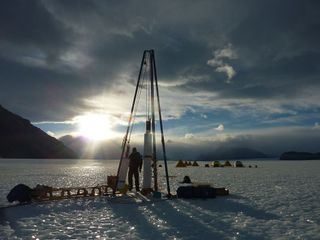
Superman's Krypton Aids Hunt for World's Oldest Ice

Radioactive krypton could help researchers track down the world's oldest ice, filling a crucial gap in Earth's climate history.
Scientists are currently searching for Antarctic ice at least 1.2 million years old. This period marks when the Earth's hot and cold rhythms started shifting from a 41,000-year cycle to today's 100,000-year cycle. Ocean sediments have yet to reveal the reasons for the change, but atmospheric gases and dust locked inside old ice could solve the climate mystery.
"There are interesting scientific questions we could answer if we had such old ice," said Christos Buizert, lead study author and a paleoclimatologist at Oregon State University in Corvallis. [Video: Ancient Antarctic Atmosphere Dated Via Krypton]
One way to find the oldest ice is to drill ice cores thousands of feet long, which involves expensive, years-long endeavors. But the longest ice cores from Antarctica and Greenland so far have uncovered only about 800,000 years of the planet's warm and cold cycles. [See Stunning Photos of Antarctic Ice]
Another solution is to analyze Antarctica's blue ice. Typically, blue ice forms where mountains block flowing ice, forcing it to surge upward. This brings older ice from the bottom to the surface, where researchers can hack out chunks with a chainsaw or using a small drill rig. Blue ice is also free of surface snow because of wind and sublimation, when snow immediately vaporizes in the air. And just 15 feet (about 5 meters) below the surface, the ice is pristine, untouched by today's atmosphere, Buizert said.

"You can just chainsaw it up and have as much ice as you want, but the difficulty is figuring out how old it is," Buizert told Live Science's Our Amazing Planet.
Scientists think Antarctica's blue ice is at least 2.5 million years old in some spots, based on meteorites and volcanic ash layers, but they've had trouble proving it. The same chemical-dating techniques that work on soil and rock don't translate well to ice.
Sign up for the Live Science daily newsletter now
Get the world’s most fascinating discoveries delivered straight to your inbox.
Now, Buizert and his co-authors show analyzing rare krypton isotopes can accurately locate and date very old Antarctic ice. (Isotopes are versions of the same element with different numbers of neutrons in their nuclei.) The findings were published today (April 21) in the Proceedings of the National Academy of Sciences.
"This new krypton method is the most precise way of telling us the age of this old ice," Buizert said.
Shipped by 'air'
Buizert collaborated with scientists at Argonne National Laboratory near Chicago, who have built a special instrument that can measure vanishingly small amounts of radioactive krypton-81. This isotope forms when cosmic rays strike inert krypton gas in the atmosphere. Measuring the isotope's decay provides an age estimate, good for about 1.5 million years. The dating technique has previously been tested on very old aquifers in the United States and Africa.
In Antarctica, krypton-81 becomes trapped inside air bubbles in snow and ice, then buried, starting its radioactive clock. Cosmic rays can't penetrate thick ice, keeping the clock pristine.
For now, the technique is limited to testing big hunks of ice, to get enough krypton. It would be impossibly expensive to ship the ice to Argonne, so the team cooked down the ice at the glacier and mailed the extracted air back to Illinois. The team melted down many 660-pound chunks (300 kilograms) while camped at Antarctica's Taylor Glacier.
"We spent two months carrying big chunks of ice around on a glacier, so we did build up some muscle mass," Buizert said. "We never got anywhere near Superman, though."
(Krypton, of course, is an inert gas, while kryptonite is a fictional green rock from the Superman's home planet that disrupts the solar energies that give him his power here on Earth. And don't forget the Fortress of Solitude, the ice castle usually located in the Arctic.)
But Argonne physicist Zheng-Tian Lu, a study co-author, said it wouldn't be long until the lab is testing 20 kg (44 pound) samples from ice cores.
"Several years ago, when the work discussed in this paper was under planning, we would need hundreds of kilograms of ice," Lu said. "Today, we need 40 to 80 kilograms [88 to 176 pounds] of ice for a Kr-81 dating analysis. We are implementing more improvements with the aim of reaching 20 kg in the near future."
Email Becky Oskin or follow her @beckyoskin. Follow us @OAPlanet, Facebook and Google+. Original article at Live Science's Our Amazing Planet.

